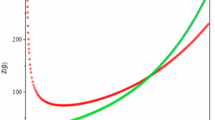Summary
Vibrational-rotational coupling in diatomic molecules has been studied by three different approaches through the solution of Schrödinger equation with a new potential. In the first and second approaches called, respectively, the closed-form method and the factorization method, analytical expressions for the energy levels, wave functions and various spectroscopic constantsviz.,α e and ωe x e have been derived. In the third method, the said potential has been treated as the Morse one with some perturbations added to it, and the perturbation method has been employed to determine the energy levels and wave functions as corrections to those for the Morse potential. In this calculation a harmonicoscillator wave function has been used as the unperturbed wave function.
Riassunto
Si è studiato l’accoppiamento vibrazionale-rotazionale nelle molecole diatomiche per tre diversi approcci attraverso la soluzione dell’equazione di Schrödinger per un nuovo potenziale. Nel primo e nel secondo approccio, chiamati rispettivamente metodo di forma chiusa e metodo di fattorizzazione, si sono derivate espressioni analitiche per i livelli di energia, funzioni d’onda e varie costanti spettroscopiche, cioè αe e ωe x e. Nel terzo metodo il suddetto potenziale è stato trattato come quello di Morse con l’aggiunta di alcume perturbazioni, e il metodo delle perturbazioni è stato impiegato per determinare i livelli di energia e le funzioni d’onda come correzioni per il potenziale di Morse. In questo calcolo si è usata la funzione d’onda per l’oscillatore armonico come funzione d’onda non perturbata.
Резюме
Исследуется вибрационно-ротационная связь в двухатомных молекулах, используя три подхода при решении уравнения Шредингера с новым потенциалом. В первом и во втором подходах, называемых соответственно метод замкнутой формы и метод факторизации, выводятся аналитические выражения для уровней энергии, волновых функций и различных спектроскопических постоянных αe и ωe x e. В третьем подходе рассматриваемый потенциал трактуется как потенциал Морса с некоторыми возмущениями. Затем используется теория возмущений для определения энергетических уровней и волновых функций, причем, в качестве невозмущенных величин используются результаты, полученные с потенциалом Морса. В этих вычислениях в качестве невозмущенной волновой функции испольеуется волновая функция гармонического осциллятора.
Similar content being viewed by others
References
J. L. Dunham:Phys. Rev.,41, 713, 722 (1932).
P. M. Morse:Phys. Rev.,34, 57 (1929). Also seeC. L. Pekeris:Phys. Rev.,45, 98 (1934) for an inclusion of rotational terms in the calculations.
G. Simons, R. G. Parr andJ. M. Finlan:Journ. Chem. Phys.,59, 3229 (1973). See alsoA. J. Thakkar:Journ. Chem. Phys.,62, 1693 (1975) for a generalization of the method.
R. Rydberg:Zeits. Phys.,73, 376 (1931);80, 514 (1933).
O. Klein:Zeits. Phys.,76, 226 (1932).
A. L. G. Rees:Proc. Phys. Soc.,59, 998 (1947).
J. T. Vanderslice andE. A. Mason:Advances in Molecular Spectroscopy (London, 1962), p. 323.
J. T. Vanderslice, E. A. Mason, W. G. Maisch andE. R. Lippincott:Journ. Mol. Spectroscopy,3, 17 (1959);5, 83 (1960).
O. Sinanoglu andK. S. Pitzer:Journ. Chem. Phys.,31, 960 (1959).
H. M. Hulburt andJ. O. Hirschfelder:Journ. Chem. Phys.,9, 61 (1941).
For reviews of these potentials seeY. P. Varshni:Rev. Mod. Phys.,29, 664 (1957);D. Steele, E. R. Lippincott andJ. T. Vanderslice:Rev. Mod. Phys.,34, 57 (1962).
L. Infeld andT. E. Hull:Rev. Mod. Phys.,23, 21 (1951).
For extensive applications and modifications of the factorization method we referJ. N. Huffaker andP. H. Dwivedi:Journ. Math. Phys.,16, 862 (1975);M. Badawi, N. Bessis, G. Bessis andG. Hadinger:Int. Journ. Quant. Chem.,11, 451 (1977);J. Phys. B,5, 1470 (1972);6, 584 (1972);Phys. Rev. A,8, 727 (1973);Canad. Journ. Phys.,52, 110 (1974).
E. Schrödinger:Proc. Roy. Irish. Acad.,46 A, 9 (1940).
C. L. Pekeris:Phys. Rev.,45, 98 (1934).Pekeris defined them asc 0=A(1−3ω+3ω2,c 1=A(4ω−6ω2) andc 2=A(−ω+3ω2), whereA=J(J+1)h 2/8π 2 Mr 2e .
F. L. Pilar:Elementary Quantum Chemistry (New York, N. Y., 1968), p. 268.
For a discussion of the treatment up to the sixth power inx seeA. M. Shorb, R. Schroeder andE. R. Lippincott:Journ. Chem. Phys.,37, 1043 (1962);L. I. Landau andE. M. Lifshitz:Quantum Mechanics (Reading, Mass., 1958), p. 136, have also given a brief discussion up to the fourth term.
Author information
Authors and Affiliations
Additional information
Traduzione a cura della Redazione.
Переведено редакцией.
Rights and permissions
About this article
Cite this article
Mohammad, S.N. Calculations of vibrational-rotational coupling constants in diatomic molecules. Nuov Cim B 49, 124–134 (1979). https://doi.org/10.1007/BF02737480
Received:
Published:
Issue Date:
DOI: https://doi.org/10.1007/BF02737480



